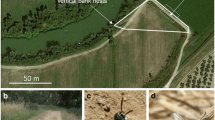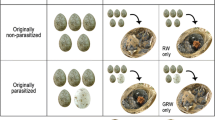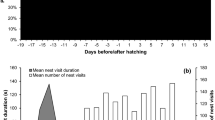Abstract
Strategies adopted by parasitoids and kleptoparasites co-evolve with the defensive adaptations of their hosts, and vice-versa. Hedychrum rutilans and Hedychrum nobile are brood parasites of, respectively, Philanthus triangulum and Cerceris arenaria, two digger wasps that share most aspects of their nesting biology (solitary females dig aggregated nests in the ground and mass-provision the brood with paralyzed insects). We tested the hypothesis that similarity in the hosts’ nesting habits corresponds to similar defensive strategies against these cuckoo wasps. Peak provisioning activity by P. triangulum occurred in late afternoon (and early morning in 1 year) while peak H. rutilans activity was in early afternoon. In contrast, peak provisioning by C. arenaria and peak H. nobile activity occurred in early afternoon. Thus, P. triangulum (as previously found in other populations) appears to have timed its provisioning to avoid its brood parasite whereas C. arenaria did not, rejecting our hypothesis. The daily activity of both chrysidid wasps was positively correlated to air temperature. Host nest density positively affected only H. rutilans activity, in agreement with previous reports for other populations of this species, whereas the daily pattern of activity of the host was the key correlate with the activity of H. nobile. Mortality due to cuckoo wasps was low for both digger wasps, although it was somewhat higher at sites with many nests of P. triangulum. We suggest that perhaps the degree to which digger wasps time their activity to avoid cuckoo wasps is related to the degree of specialization in host choice by their brood parasite. H. rutilans is more highly dependent on P. triangulum, which may have had a greater effect on the timing of provision by its host.






Similar content being viewed by others
References
Antonini Y, Martins RP, Rosa CA (2003) Inverse density-dependent and density-independence in a solitary nesting bee in Southeast Brazil. Trop Zool 16:83–92
Clancy KM, Price PW (1987) Temporal variation in three-trophic level interactions among willows, sawflies and parasites. Ecology 67:1601–1607
Endo A (1980) On the host–cleptoparasite relationship between the spider wasp Episyron arrogans (Smith) (Hymenoptera, Pompilidae) and the miltogrammine fly Metopia sauteri (Townsend) (Diptera, Sarcophagidae). Jap J Ecol 30:117–132
Evans HE, O’Neill KM (1988) The Natural History and Behavior of North American Beewolves. Cornell University Press, Ithaca
Evans HE, O’Neill KM (2007) The Sand Wasps: Behavior and Natural History. Harvard University Press, Cambridge
Evans HE, Kurczewski FE, Alcock J (1980) Observations on the nesting behaviour of seven species of Crabro (Hymenoptera, Sphecidae). J Nat Hist 14:865–882
Grandi G (1961) Studi di un entomologo sugli Imenotteri Superiori. Boll Ist Ent Univ Bologna 25:1–659
Hager BJ, Kurczewski FE (1985) Cleptoparasitism of Ammophila harti (Fernald) (Hymenoptera: Sphecidae) by Senotainia vigilans Allen, with observations on Phrosinella aurifacies Downes (Diptera: Sarcophagidae). Psyche 92:451–462
Herzner G, Strohm E (2007) Fighting fungi with physics: food wrapping by a solitary wasp prevents water condensation. Curr Biol 17:46–47
Kaltenpoth M, Göttler W, Herzner G, Strohm E (2005) Symbiotic bacteria protect wasp larvae from fungal infestation. Curr Biol 15:475–479
Kaltenpoth M, Göttler W, Dale C, Stubblefield JW, Herzner G, Roeser-Mueller K, Strohm E (2006) ‘Candidatus Streptomyces philanthi’, an endosymbiotic streptomycete in the antennae of Philanthus digger wasps. Int J Syst Evol Microbiol 56:1403–1411
Kimsey LS, Bohart R (1990) The Chrysidid Wasps of the World. Oxford University Press, Oxford
Kroiss J, Bordon S, Strohm E (2008) Hydrocarbons in the nest material of a solitary digger wasp represent a kairomone for a specialized cuckoo wasp. Anim Behav 76:1555–1563
Kroiss J, Schmitt T, Strohm E (2009) Low level of cuticular hydrocarbons in a parasitoid of a solitary digger wasp and its potential for concealment. Entomol Sci 12:9–16
Li H, Futch SH, Syvertsen JP (2007) Cross-correlation patterns of air and soil temperatures, rainfall and Diaprepes abbreviatus root weevil in citrus. Pest Management Sci 63:1116–1123
Linsenmaier W (1959) Revision der Familie Chrysididae. Mitteilungen der Schweizerischen Entomologischen Gesellschaft 32:1–240
McCorquodale DB (1986) Digger wasp (Hymenoptera: Sphecidae) provisioning flights as a defense against a nest parasite, Senotainia trilineata (Diptera: Sarcophagidae). Can J Zool 64:1620–1627
Melo GAR (1999) Phylogenetic relationships and classification of the major lineages of Apoidea (Hymenoptera), with emphasis on the crabronid wasps. Scientific Papers, Natural History Museum, the University of Kansas 14:1–55
Mingo E (1994) Hymenoptera, Chrysididae. Fauna Iberica 6. Museo Nacional de Ciencias Naturales, CSIC, Madrid
Molumby A (1995) Dynamics of parasitism in the organ-pipe wasp, Trypoxylon politum: effects of spatial scale on parasitoid functional response. Ecol Entomol 20:159–168
Morgan D (1984) Cuckoo-wasps. (Hymenoptera, Chrysididae). Handbooks for the Identification of British Insects 6:1–37
O’Neill KM (2001) Solitary Wasps: Behaviour and Natural History. Cornell University Press, Ithaca
Polidori C, Disney RHL, Andrietti F (2004) Some observations on the reproductive biology of the scuttle fly Megaselia andrenae (Diptera: Phoridae) at the nesting site of its host Andrena agilissima (Hymenoptera: Andrenidae). Eur J Entomol 101:337–340
Polidori C, Boesi R, Isola F, Andrietti F (2005a) Provisioning patterns and choice of prey in the digger wasp Cerceris arenaria (Hymenoptera: Crabronidae): the role of prey size. Eur J Entomol 102:801–804
Polidori C, Scanni B, Scamoni E, Giovanetti M, Paxton RJ, Andrietti F (2005b) Satellite flies (Leucophora personata, Diptera: Anthomyiidae) and other dipteran parasites of the communal bee Andrena agilissima (Hymenoptera: Andrenidae) on the island of Elba, Italy. J Nat Hist 39:2745–2758
Polidori C, Papadia C, Disney RHL, Andrietti F (2006a) Behaviour and activity patterns of the scuttle fly Megaselia oxybelorum (Diptera: Phoridae) at aggregations of two host digger wasps (Hymenoptera: Crabronidae). J Nat Hist 40:1969–1982
Polidori C, Casiraghi M, Di Lorenzo M, Valarani B, Andrietti F (2006b) Philopatry, nest choice and aggregation temporal–spatial change in the digger wasp Cerceris arenaria (Hymenoptera: Crabronidae). J Ethol 24:155–163
Polidori C, Borruso L, Boesi R, Andrietti F (2009) Segregation of temporal and spatial distribution between kleptoparasites and parasitoids of the eusocial sweat bee, Lasioglossum malachurum (Hymenoptera: Halictidae). Entomol Sci 12:116–129
Polidori C, Mendiola P, Asís JD, Tormos J, Selfa J (2010) Temporal asynchrony and spatial co-occurrence with the host: the foraging patterns of Nemka viduata, a parasitoid of digger wasps (Hymenoptera: Mutillidae and Crabronidae). J Ethol doi:10.1007/s10164-009-0196-2
Rosenheim JA (1988) Behaviorally mediated spatial and temporal refugees from a cleptoparasite, Argocrysis armilla (Hymenoptera: Chrysididae), attacking ground nesting wasp, Ammophila dysmica (Hymenoptera: Sphecidae). Behav Ecol Sociobiol 25:335–348
Rosenheim JA (1990) Density-dependent parasitism and evolution of aggregated nesting in the solitary Hymenoptera. Ann Entomol Soc Am 83:277–286
Rosenheim JA, Meade T, Powich IG, Schoenig SE (1989) Aggregation by foraging insect parasitoids in response to local variations in host density: determining the dimensions of a host patch. J Anim Ecol 58:101–117
Simon Thomas RT, Simon Thomas AMJ (1972) Some observations on the behaviour of females of Philanthus triangulum (F.) (Hymenoptera: Sphecidae). Tijdschr Entomol 115:123–139
Strohm E, Linsenmair KE (2000) Allocation of parental investment among individual progeny in the European beewolf Philanthus triangulum F. (Hymenoptera, Sphecidae). Biol J Linn Soc 69:173–192
Strohm E, Laurien-Kehnen C, Bordon S (2001) Escape from parasitism: spatial and temporal strategies of a sphecid wasp against a specialised cuckoo wasp. Oecologia 129:50–57
Strohm E, Kroiss J, Herzner G, Laurien-Kehnen C, Boland W, Schreier P, Schmitt T (2008) A cuckoo in wolves’ clothing? Chemical mimicry in a specialized cuckoo wasp of the European beewolf (Hymenoptera, Chrysididae and Crabronidae). Front Zool 5:2
Tengö J, Baur B (1993) Number and size of oocytes in relation to body size and time of day in the kleptoparasitic bee Nomada lathburiana (Hymenoptera: Anthophoridae). Entomol Gen 18:19–24
Tsuneki K (1970) A guide to the study of the Japanese Hymenoptera. Chrysididae I. Life Study (Fukui) 14:45–50
Veenendaal RL (1987) The hidden egg of Hedychrum rutilans (Chrysididae). Entomol Ber 47:169–171
Wcislo WT, Arneson L, Roesch K, Gonzalez V, Smith A, Fernandez H (2004) The evolution of nocturnal behaviour in sweat bees, Megalopta genalis and M. ecuadoria (Hymenoptera: Halictidae): an escape from competitors and enemies? Biol J Linn Soc 83:377–387
Witt R (1998) Wespen: beobachten, bestimmen. Naturbuch, Augsburg
Acknowledgments
Thanks are due to Maurizio Pavesi (Museo di Storia Naturale di Milano) for the cuckoo wasps determination; to Roberto Fumagalli, Sara Occhipinti, and Alice Mocellin for the help in collecting the field data; and to the Ticino Regional Park, the Adda Sud Regional Park, and Antonio Bianchi to facilitate the field study. Erhard Strohm, Thomas Schmitt, Allan Hook, and John Alcock critically and constructively reviewed the manuscript, gave many suggestions, and revised the English. The present work was supported by a 3-year grant FIRB (Fondo per gli Investimenti della Ricerca di Base) RBAU019H94-001 (2001).
Author information
Authors and Affiliations
Corresponding author
Rights and permissions
About this article
Cite this article
Polidori, C., Bevacqua, S. & Andrietti, F. Do digger wasps time their provisioning activity to avoid cuckoo wasps (Hymenoptera: Crabronidae and Chrysididae)?. acta ethol 13, 11–21 (2010). https://doi.org/10.1007/s10211-010-0067-4
Received:
Revised:
Accepted:
Published:
Issue Date:
DOI: https://doi.org/10.1007/s10211-010-0067-4




